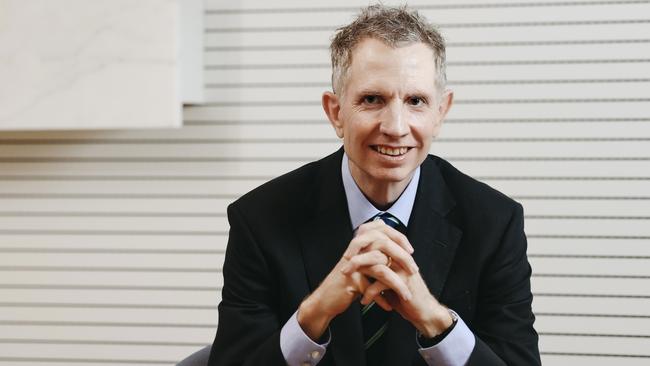Australian Retirement Trust shifts bulk of balance customers to higher growth strategies
Australian Retirement Trust, the nation’s second-largest superannuation fund, is about to shift over 2 million members into a riskier strategy in a bid to turbocharge returns.

Australian Retirement Trust, the nation’s second-largest superannuation fund, is days away from pushing millions of its members up the risk curve in a bid to turbocharge returns.
Throwing down the gauntlet to its rivals as competition for member growth heats up, the $285bn megafund is overhauling its default investment strategy to chase returns that could end up dwarfing those at funds with the typical balanced fund.
Australian Retirement Trust (ART), formed through the merger of Sunsuper and QSuper in 2022, will from July 1 shift the bulk of its 2.4 million members from the balanced pool of its life-cycle strategy to the high-growth pool, where their retirement savings will be overwhelmingly invested in growth assets such as equities and private equity.
It is a major change from the fund’s current default investment mix, where 30 per cent of assets are invested in defensive investments, including 14 per cent in fixed income.
The move by ART to shift its members up the risk curve, with the expectation of outsized returns, puts into focus the growing chasm between funds whose default MySuper option is the typical 70/30 balanced fund, including the nation’s largest, the $330bn AustralianSuper, and those with default high growth or life-cycle strategies, such as ART and peer Aware Super.
AustralianSuper has returned 8.4 per cent return in its default balanced option over the 2023 financial year to June 20, while at Hostplus, another major fund, the balanced strategy had risen 6.9 per cent up to May 31 (the latest data available).
ART’s high-growth investment option, meanwhile, is on track to return about 12 per cent for the current financial year, which closes out at the end of this week, while its balanced option is already among the top performers in the market today, with an expected 10 per cent return for the year.
The median balanced option returned 8 per cent for the first 11 months of the year, while the median growth option gained 10 per cent over the same period, according to research house SuperRatings.
From July, everyone under the age of 50 in ART’s default life-cycle strategy – and that is the vast majority of its members – will move to the high-growth pool, where about 65 per cent of assets will be invested in listed equities (both Australian and global), 10 per cent in private equity, and about 5 per cent in alternatives.
Fixed income will account for 2 per cent of assets and there will be little or no cash allocation.
Those between the ages of 50 and 65 will gradually be moved down the risk curve to an eventual allocation of 80 per cent balanced and 20 per cent cash.
ART chief investment officer Ian Patrick said the fund had taken the decision to shift members into the higher-returning growth pool because it would lead to a better outcome in retirement.
“This is about delivering the right strategy for a member’s outcomes at retirement through the entire investing period. Almost any study will show that over the long term, exposure to growth assets will deliver you a superior outcome,” Mr Patrick told The Australian.
“If you look at the international experience, target date funds in the US, similar life-cycle options in the UK or even in Australia, the exposure to a higher proportion of growth assets at the younger ages is quite a consistent theme. And we felt it was time to look at our own experience, look at the evidence, and increase the proportion to growth assets.”
While Aware Super, the third-largest super fund in the market, also applies a life-cycle strategy for its members, keeping them in the high-growth pool until aged 55, AustralianSuper does not. But the fund is not ruling it out as a future option.
“AustralianSuper regularly reviews its products and options and a life-cycle strategy may be something that we consider in the future,” the fund’s head of superannuation and retirement product, Dena Brockie, told The Australian.
“Life-cycle strategies have an intuitive appeal, but they must be applied with care. There are important considerations including the fact that many members have long investment horizons, even at retirement age.
“Wealth is often the most important factor in determining a default strategy, not age, which is what most life-cycle strategies are based on.”
Fees at ART, meanwhile, will increase for the vast majority of its 2.4 million members alongside the investment changes, from an estimated $472.40 a year in the balanced pool with a balance of $50,000, to $517.40 a year in the high growth pool, for a difference of $45.
ART is on the higher end for fees when compared to its peers. AustralianSuper’s annual fee on a $50,000 balance is $382, while Unisuper charges members about $350 a year.
Addressing ART’s fees and the $45 difference between the annual fee for the balanced and high growth pools, Mr Patrick said it came down to the higher allocation to private equity in the latter.
“Growth has higher exposures to private equity and we believe that’s really important in terms of long term returns,” he said. “Private equity is the most expensive asset class but, over a full investing life cycle because of the return premium that private equity earns, we think that a very moderate uplift in fee is more than rewarded by the excess return.”






To join the conversation, please log in. Don't have an account? Register
Join the conversation, you are commenting as Logout